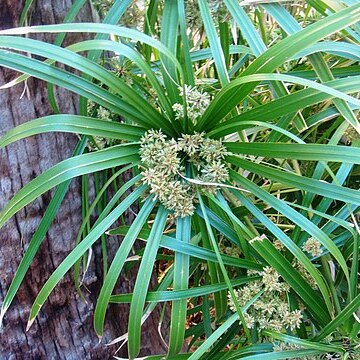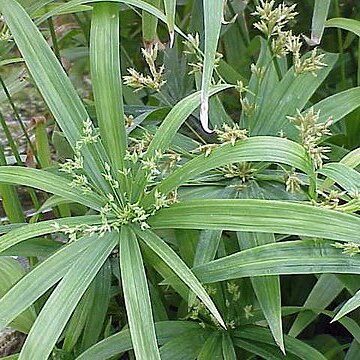Herbs, perennial or less often annual, cespitose or not, rhizomatous, stoloniferous, rarely tuberous. Culms solitary or not, trigonous or round, glabrous or scabridulous with extrorse or antrorse (rarely retrorse) prickles. Leaves usually basal; ligules absent; blades keeled abaxially, flat, V-, or inversely W-shaped in cross section. Inflorescences terminal, rarely pseudolateral, 1st order subumbellate to capitate, 2d order with spicate or digitately arranged spikelets, rarely a solitary spikelet; spikelets 1–150; 1st order rays unequal (rarely equal) in length, produced singly from the axils of inflorescence bracts; involucral bracts 1–22, spirally arranged at culm apex, spreading to erect, leaflike. Spikelets: scales to 76, distichous, each subtending flower, cylindric to compressed, borne spicately or digitately at ends of rays (occasionally proliferous). Flowers bisexual [rarely unisexual], in axils of distichous floral scales, bases often decurrent onto rachilla as ± hyaline wings; perianth absent; stamens 1–3; styles linear, 2–3-fid, base deciduous or persistent; stigmas 2–3. Achenes biconvex, flattened, or trigonous.
Herbs, annual or perennial, with rhizomes or stolons. Culms caespitose or solitary, erect, usually 3-angled or acutely triquetrous, sometimes compressed triquetrous, stout or slender, leafy at basal part or at base. Leaves basal, 3-ranked, rarely without a blade; ligule absent. Involucral bracts leaflike, usually 2-10(-20 or more), at base of inflorescence. Inflorescences terminal, a simple or compound anthela, with several to many rays and usually with raylets (secondary rays); rays and raylets unequal or rarely equal in length or inflorescence capitate. Spikelets few to many in spikes, digitate clusters, or a capitulum at apex of rays, rarely single; rachilla not articulate at base, persistent, usually with narrow wings. Glumes distichous, rarely spirally imbricate; basal 1 or 2 glumes without a flower; remaining glumes each with a bisexual flower. Perianth bristles or scales absent. Stamens (1-)3. Style base not swollen; stigmas (2 or)3, deciduous at maturity. Nutlet 3-sided, smooth, puncticulate, tuberculate, or rarely reticulately striate.
Scales distichous, the lowermost one empty and ± modified; fls perfect, each in the axil of a scale; perianth wanting; stamens 3, less often 1 or 2; style 2–3-cleft, the beakless (or nearly beakless) achene accordingly lenticular or ± trigonous; spikelets few–many in dense or loose spikes or heads, each subtended by 2 small bracts; spikes or heads commonly in a simple or compound terminal umbel that is subtended by sheathless, leafy invol bracts; each ray of the umbel surrounded at base by a tubular prophyll; herbs with solid, ± triangular stems, the lvs with closed sheath and usually an elongate, grasslike blade. 600+, cosmop. Our spp. belong to 5 subgenera, as in the following key. Spp. 14–22 and 23–28 appear to be intergradient, presumably reflecting extensive hybridization.
Annual, or perennial, often rhizomatous herbs. Stems leafy at base or leaves reduced to basal sheaths. Inflorescence umbellate or capitate, surrounded by 1-several leaf-like involucral bracts. Spikelets compressed or subterete, 1-many-flowered, usually clustered in spikes at tips of rays or in a sessile spike. Flowers hermaphrodite. Glumes distichous, usually all fertile. Hypogynous bristles 0. Stamens 2-3, or 1. Style 2-3-fid, continuous with ovary, not thickened at base. Nut trigonous or biconvex. A tropical and warm temperate genus of c. 550 spp., one endemic in N.Z.; 13 adventive.
Infl. a terminal umbel-like corymb or reduced to a single head or spikelets. Spikelets compressed or subterete, 1-∞-fld; fls hermaphrodite or the terminal 1–3 occ. male. Glumes distichous. Hypog. bristles 0. Stamens 2–3, or 1. Style 2–3-fid, continuous with ovary, not thickened at base. Nut triquetrous or plano-convex. Annual or perennial, often rhizomatous herbs. Stems lfy at base, or lvs reduced to sheaths. A tropical and warm temperate genus of c. 550 spp.; the N.Z. sp. endemic.
Annuals or perennials, the culms simple, usually triangular and leafy; inflores-cence involucrate in dense spikes or in clusters, capitate or on rays which are often compound; spikelets flat or subterete, few-or many-flowered, the rachis often winged, the scales concave, 2-ranked; flowers perfect; perianth none; stamens 1-3; style 2-to 3-cleft; achene lenticular or 3-angulate.


